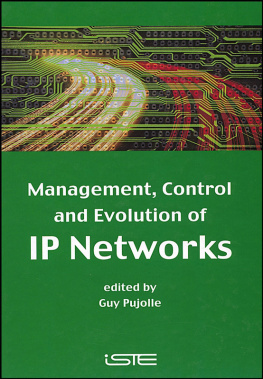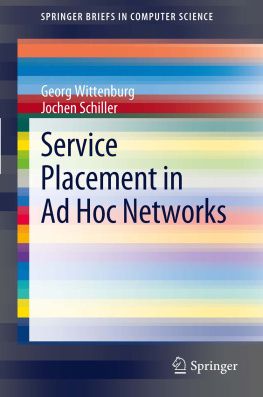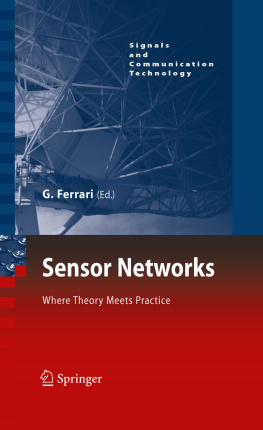Table of Contents

Parts of this book adapted from Linternet ambiant (2004), Les volutions du monde IP and Contrle dans les rseaux IP (2005) published in France by Herms Science/Lavoisier First Published in Great Britain and the United States in 2007 by ISTE Ltd
Apart from any fair dealing for the purposes of research or private study, or criticism or review, as permitted under the Copyright, Designs and Patents Act 1988, this publication may only be reproduced, stored or transmitted, in any form or by any means, with the prior permission in writing of the publishers, or in the case of reprographic reproduction in accordance with the terms and licenses issued by the CLA. Enquiries concerning reproduction outside these terms should be sent to the publishers at the undermentioned address:
| ISTE Ltd | ISTE USA |
| 6 Fitzroy Square | 4308 Patrice Road |
| London W1T 5DX | Newport Beach, CA 92663 |
| UK | USA |
| www.iste.co.uk |
ISTE Ltd, 2007
LAVOISIER, 2004, 2005
The rights of Guy Pujolle to be identified as the author of this work have been asserted by him in accordance with the Copyright, Designs and Patents Act 1988.
Library of Congress Cataloging-in-Publication Data
Management, control, and evolution of IP networks/edited by Guy Pujolle.
p. cm.
Parts of this book adapted from Linternet ambient (2004), Les volutions du monde IP and Contrle dans les rseaux IP (2005) published in France by Hermes Science/Lavoisier.
Includes index.
ISBN-13: 978-1-905209-47-7
1. Computer networks. 2. TCP/IP (Computer network protocol) I. Pujolle, G., 1949-TK5105.5.M35767 2006
004.62--dc22
2006033295
British Library Cataloguing-in-Publication Data
A CIP record for this book is available from the British Library
ISBN 13: 978-1-905209-47-7
Packet-switched networks form a very complex and difficult to control world. With circuit switching networks, if all circuits are busy, the network cannot accept additional clients. With networks that move information in packets, the limit where they stop accepting new clients is vague. The primary objective of IP network control is to determine that limit. Other major objectives are: avoiding congestion when a node is completely blocked, putting in place security components, managing client mobility, etc.
This chapter is meant as an overview of some of the important control mechanisms in IP networks. We will start with flow control, which can be done in different ways, such as the opening of another node with generally important priorities on that node or the statistical utilization of resources, as will be shown with DiffServ technology.
The major requirement for efficient control is based on the presence of messages capable of transmitting control information. The system that will generate these messages is called a signaling network: events and decisions must be flagged. Signaling information transmission is a major component of network infrastructure. One can go so far as to say that the future of networks resides in our capacity to drive and automate their configuration. Signaling objective means flagging information, for example, the control and set-up activation of a new route or reserving a part of the infrastructure in order for a software application to run efficiently. Signaling has long been studied by normalization groups, especially the ITU-T. It has greatly evolved in the last 10 years and must continue to adjust as the IP world changes. The Internets normalization group, IETF, has partially taken over particularly the integration of telephony over IP environments.
Internet flows also require control. If we want to achieve QoS (Quality of Service), it is imperative that we control the flows and the network has to be capable of slowing down or accelerating them according to their importance. Another way of controlling a network is to implement rules according to users requests. This solution has been developed a few years ago and is called Policy-Based Management (PBM).
Some network functionalities also require rigorous control, such as security and mobility. Let us start by introducing security control mechanisms and then move to mobility management in a network where terminal units can move while remaining connected to the network. In this book, we will detail these extremely important control mechanisms. Finally, we will go to the core of the networks as we will discuss optical networks.
These control mechanisms will be examined briefly in this chapter. The first section of this chapter is a quick overview of signaling. This section will introduce some basic notions with examples, then we will examine flow and congestion control mechanisms, followed by PBM and security and mobility management. We will finish with a discussion on the management of the core of the network.
Signaling means the steps that need to be put in place in order for the information to be transmitted, such as the set-up or closing of a path. It is present in all networks, including those such as IP, that need signaling in its most basic form in order to preserve the systems simplicity. Signaling must therefore be able to function in all network environments, especially IP networks.
Signaling usually needs to function in routing mode. Indeed, it is essential to indicate to whom the signaling is addressed and, in order to do that, the complete address of the receiver must be indicated in the signaling packet. Therefore, all switched networks need a routing process in order to activate signaling.
Signaling functionality is capable of taking over services at different levels of the architecture. For example, it must be able to negotiate SLA (Service Level Agreement) in order to request user authentification, to collect information on available resources, etc. Signaling protocols must be expandable in order to easily accept new services. Furthermore, signaling protocols must be modular and flexible in order to respond accurately to the needs of each software application. Modularity facilitates the addition of new modules during development phases.
1.2.1. Signaling operation
A signaling protocol has two operation modes: inband and outband. In inband mode, signaling messages are transmitted in the data path, whereas in outbound mode, they are independent of the path followed by the data.
Another characteristic of signaling is path-coupling or path-decoupling possibilities. In the case of path-coupling, signaling follows inband or outband data using the same node order. For example, the RSVP protocol is path-coupled and the SIP protocol is path-decoupled.
Signaling must be able to operate in inter-domain or intra-domain modes. Signaling must also function in end-to-end, border-to-border and end-to-edge (signaling between an end-host and an edge-node) modes.
In the current heterogenous Internet environment, there are a good number of signaling protocols, generally adapted to the multiple existing applications. This has led the IETF to create the NSIS (Next Step in Networking) task force whose responsibility it is to come up with a new single standard designed to combine all previous protocols.
As a general rule, a signaling protocol must be able to cooperate with other protocols. In order to do this, it must be able to transport messages from other signaling protocols. It is also possible to define interfaces making it possible to transform a message concerning a protocol into a message concerning another protocol.
Next page









